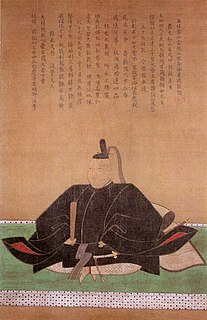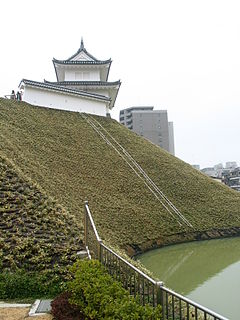
The Matsudaira clan was a Japanese samurai clan that descended from the Minamoto clan. It originated in and took its name from Matsudaira village, in Mikawa Province. During the Sengoku period, the chieftain of the main line of the Matsudaira clan, Matsudaira Motoyasu became a powerful regional daimyo under Oda Nobunaga and Toyotomi Hideyoshi and changed his name to Tokugawa Ieyasu. He subsequently seized power as the first shōgun of the Tokugawa shogunate which ruled Japan during the Edo period until the Meiji restoration of 1868. Under the Tokugawa shogunate, many cadet branches of the clan retained the Matsudaira surname, and numerous new branches were formed in the decades after Ieyasu. Some of those branches were also of daimyō status.

Yamagata Domain was a feudal domain in Edo period Japan, located in Dewa Province, Japan. It was centered on Yamagata Castle in what is now the city of Yamagata. Unlike some han whose control was relatively stable throughout the Edo period (1603–1867), Yamagata changed hands a great number of times during its history.
Annaka Domain was a feudal domain under the Tokugawa shogunate of Edo period Japan, located in Kōzuke Province, Japan. It was centered on Annaka Castle in what is now the city of Annaka, Gunma.

Tatebayashi Domain was a feudal domain under the Tokugawa shogunate of Edo period Japan, located in Kōzuke Province, Japan. It was centered on Tatebayashi Castle in what is now the city of Tatebayashi, Gunma.

Kuwana Domain was a Japanese domain of the Edo period, located in Ise Province, Japan. It was centered on Kuwana Castle in what is now the city of Kuwana, Mie.

Okazaki Domain was a feudal domain of the Tokugawa shogunate in Edo period, Japan located in eastern Mikawa Province, Japan. It was centered on Okazaki Castle in what is now the city of Okazaki, Aichi. It was ruled by a number of different fudai daimyō over the course of the Edo period. Due to its associations with Tokugawa Ieyasu, who was born in Okazaki Castle, the domain had a prestige greater than in its nominal valuation based on rice tax revenues.

Tendō Domain was a feudal domain in Edo period Japan, located in Dewa Province, Japan. It was centered in what is now the city of Tendō, Yamagata. Tendō was ruled by the tozama Oda clan, direct descendants of the famed Oda Nobunaga, throughout its history. Although styled with the honorific of "castle", the clan residence was in fact a jin'ya, or fortified house.
Kanō Domain was a fudai feudal domain of Edo period Japan. The domain was centered at Kanō Castle, located in what is now part of the city of Gifu in Gifu Prefecture.

Kakegawa Domain was a feudal domain under the Tokugawa shogunate of Edo period Japan. The domain was centered at Kakegawa Castle in Tōtōmi Province, in what is now the city of Kakegawa, Shizuoka.

Matsushiro Domain was a feudal domain under the Tokugawa shogunate of Edo period Japan. It is located in Shinano Province, Honshū. The domain was centered at Matsushiro Castle, located in what is now part of the city of Nagano in Nagano Prefecture.

Matsudaira Tadaaki was a Japanese samurai of the Azuchi-Momoyama Period through early Edo period. He was a retainer and relative of the Tokugawa clan.
Nanokaichi Domain was a feudal domain under the Tokugawa shogunate of Edo period Japan, located in Kōzuke Province, Japan. It was centered on Nanokaichi jin'ya in what is now part of the city of Tomioka, Gunma. Parts of the jin'ya, including the daimyō residence and gardens are preserved on the original site. Nanokaichi was ruled throughout its history by a junior branch of the Maeda clan of Kaga.

Suwa Domain was a feudal domain under the Tokugawa shogunate of Edo period Japan. It was located in Shinano Province, Honshū. The domain was centered at Takashima Castle, located in what is now part of the town of Suwa in Nagano Prefecture. It was also known as Takashima Domain.

Kariya Domain was a feudal domain of the Edo period Tokugawa shogunate located in Mikawa Province, Japan, what is now part of the modern-day cities of Kariya and Anjō. It was centered on Kariya Castle, which was located in what is now the city of Kariya.

Takasaki Domain was a feudal domain under the Tokugawa shogunate of Edo period Japan, located in Kōzuke Province, Japan. It was centered on Takasaki Castle in what is now part of the city of Takasaki, Gunma. Takasaki was ruled through most of its history by a junior branch of the Matsudaira clan.

Isesaki Domain was a feudal domain under the Tokugawa shogunate of Edo period Japan, located in Kōzuke Province, Japan. It was centered on Isesaki jin'ya in what is now part of the city of Isesaki, Gunma. Isesaki was ruled through most of its history by a junior branch of the Sakai clan.

Maebashi Castle is a Japanese castle located in Maebashi, central Gunma Prefecture, Japan. At the end of the Edo period, Maebashi Castle was home to a branch of the Matsudaira clan, daimyō of Maebashi Domain, although the castle was ruled by a large number of different clans over its history. The castle was also known as "Mayabashi-jō" (厩橋城), after the former name of Maebashi.

Maebashi Domain was a feudal domain under the Tokugawa shogunate of Edo period Japan, located in Kōzuke Province, Japan. It was centered on Maebashi Castle in what is now part of the city of Maebashi, Gunma.
Yoshii Domain was a feudal domain under the Tokugawa shogunate of Edo period Japan, located in Kōzuke Province, Japan. It was centered on Yoshii jin'ya in what is now part of the city of Takasaki, Gunma. Yoshii was ruled through much of its history by a branch of the Takatsukasa clan, which had adopted the patronym of Matsudaira.

Utsunomiya Domain was a feudal domain under the Tokugawa shogunate of Edo period Japan, located in Shimotsuke Province, Japan. It was centered on Utsunomiya Castle in what is now part of the city of Utsunomiya. Utsunomiya was ruled by numerous daimyō clans during its history.
















